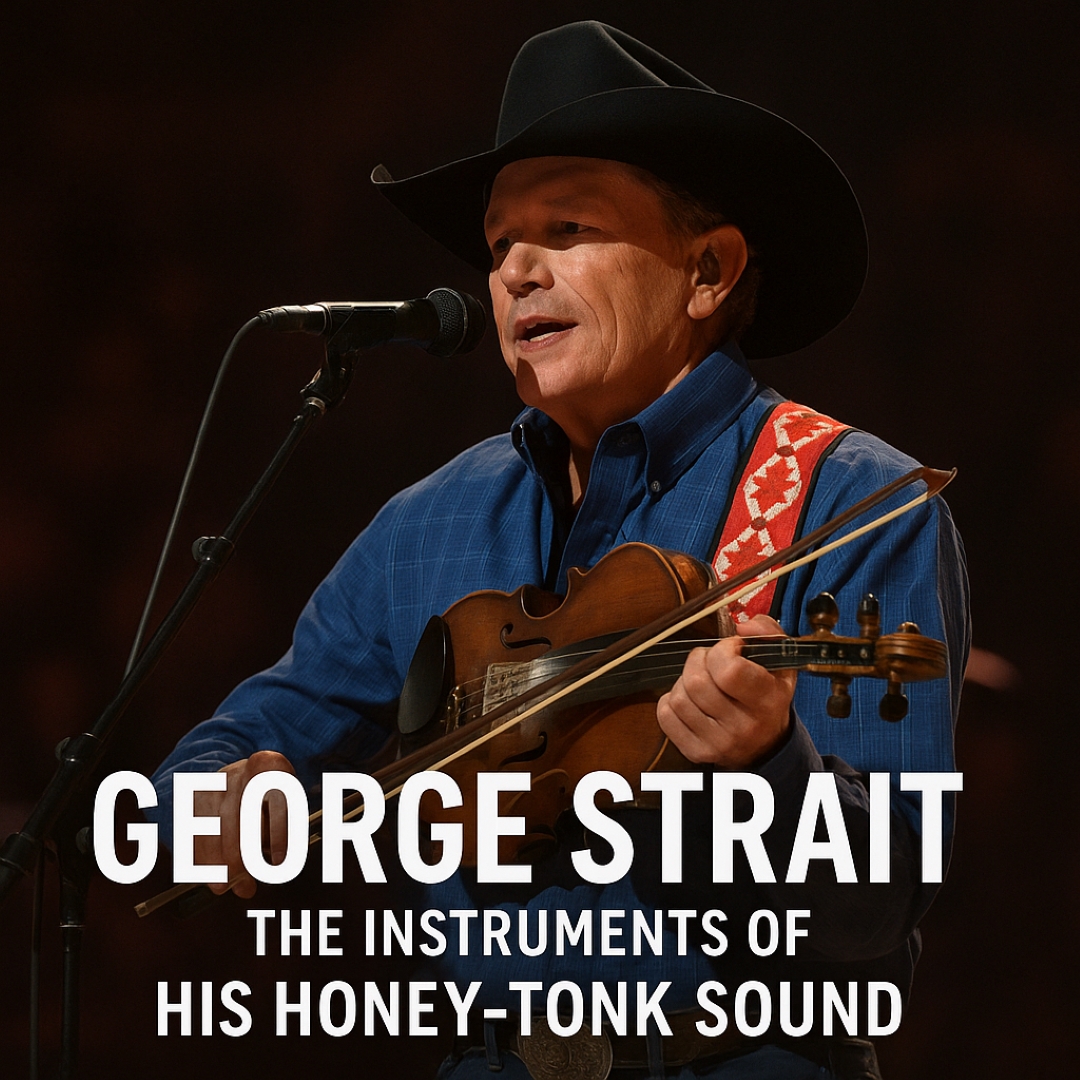When people talk about George Strait, the conversation almost always circles back to one thing: authenticity. For over four decades, the “King of Country” has stayed true to the core of traditional country music while navigating the shifting sands of Nashville trends. But what exactly makes a George Strait song feel so distinctly Strait? The answer lies not just in his smooth Texas drawl or his understated charisma—it’s also in the instruments that have defined his sound: the fiddle, the steel guitar, and the honky-tonk heartbeat they create together.

🎶 The Fiddle – The Voice of Tradition
The fiddle has been at the center of country music for centuries, and in George Strait’s catalog, it plays an indispensable role. From the moment the bow hits the strings, it evokes the wide-open Texas landscapes Strait calls home. Songs like “Amarillo by Morning” wouldn’t feel the same without the plaintive cry of the fiddle, weaving in and out of Strait’s steady vocal line.
The fiddle in Strait’s songs rarely tries to steal the spotlight. Instead, it acts like a storyteller’s companion, amplifying the emotion behind his lyrics. In love songs, it sighs with tenderness. In heartbreak ballads, it mourns right alongside him. This subtlety is part of the magic—by never overwhelming the arrangement, the fiddle allows Strait’s voice to remain the centerpiece, while still imbuing the track with authenticity.
For many fans, the fiddle is what grounds Strait’s music firmly in the lineage of traditional country, connecting him to pioneers like Bob Wills and the Texas Playboys. It’s the thread that ties his songs to a tradition older than him, yet fresh every time he performs.
🎸 The Steel Guitar – Country’s Emotional Compass
If the fiddle represents tradition, the steel guitar is the emotional compass of George Strait’s music. Few instruments capture the ache of longing or the sweetness of love like the steel. Its soaring glides and heart-tugging bends give Strait’s catalog a sound that feels both timeless and unmistakably country.
Take a song like “The Chair.” Without the steel guitar softly bending in the background, the conversation-in-song might lose its charm and subtle drama. Or listen to “Ocean Front Property,” where the steel creates waves of irony that complement Strait’s deadpan delivery. In each case, the steel guitar acts almost like an invisible character in the narrative, coloring the story with nuance.
The instrument is also a key reason why Strait’s songs resonate across generations. Younger fans may not realize it consciously, but the steel guitar’s presence distinguishes his music from the heavily pop-influenced country dominating the radio today. It’s an instrument that doesn’t just accompany the voice—it echoes the heart behind it.
🤠 The Honky-Tonk Soul – Where Fiddle and Steel Meet
George Strait’s genius lies in how he balances these instruments with his own voice to create something instantly recognizable. The fiddle and steel guitar aren’t just background—they’re partners in storytelling. Together, they embody the honky-tonk soul, a sound that resonates with anyone who has walked into a dimly lit Texas dancehall, where boots shuffle against the wooden floor and neon lights flicker above the bar.
It’s in these moments that Strait’s music feels like a living, breathing portrait of country life. Songs like “All My Ex’s Live in Texas” wouldn’t sparkle with the same humor without the playful interplay of fiddle and steel. Meanwhile, ballads like “You Look So Good in Love” carry their emotional weight because of how these instruments gently cradle the melody.
The honky-tonk influence in Strait’s music isn’t about being flashy. It’s about honesty. It’s about making people dance, laugh, cry, or remember someone they loved. The instruments work together to create a soundtrack that feels lived-in, familiar, and deeply human.
🌵 The Texas Dancehall Connection
Strait’s early years with his Ace in the Hole Band cemented this sound. Unlike many Nashville acts who leaned heavily into polished studio recordings, Strait built his reputation playing night after night in small Texas bars and dancehalls. In those settings, the fiddle and steel guitar weren’t optional—they were essential. They gave dancers the rhythm and texture they craved. They filled the air with warmth, laughter, and occasionally tears.
When Strait eventually broke into the national scene, he didn’t abandon this foundation. Instead, he brought the Texas dancehall sound to Nashville, reshaping country radio in the process. It was a reminder to the industry that traditional instruments weren’t relics—they were the heartbeat of the genre.
🎤 Strait’s Voice as the Anchor
Of course, none of this would work without George Strait’s voice tying it all together. His delivery is famously smooth and understated, never overpowering the instruments but always guiding them. The fiddle and steel guitar orbit around his vocals, giving them context and depth.
This restraint is rare. Many artists feel the need to dominate every track, but Strait understands that true power lies in balance. By letting the instruments breathe, he allows his music to resonate in a way that feels timeless. His voice tells the story, but the fiddle and steel guitar provide the emotion, making each performance unforgettable.
🎼 A Legacy of Sound
Looking back at George Strait’s career, it’s clear that his success isn’t just about hit songs or sold-out stadiums—it’s about preserving a sound. In an era where country often blurs into pop or rock, Strait has remained loyal to the instruments that define the genre. The fiddle and steel guitar aren’t just tools; they’re characters in the narrative of his music. They remind us that country, at its best, is about simplicity, honesty, and connection.
Fans may debate which Strait song is the best, but nearly all would agree: without the fiddle and steel guitar, it wouldn’t be George Strait. They are the soul of his music, the brushstrokes that paint his stories, and the reason his songs continue to feel both timeless and deeply personal.